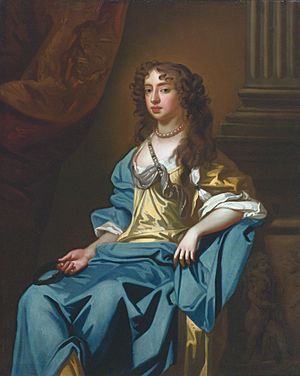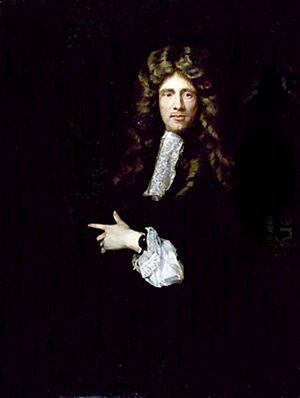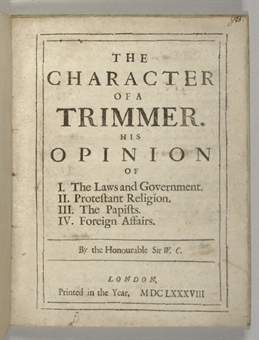George Savile, 1st Marquess of Halifax facts for kids
Quick facts for kids
The Most Honourable
The Marquess of Halifax
|
|
|---|---|

George Savile, Marquess of Halifax, by Mary Beale, circa 1674–1676
|
|
| Lord President of the Council | |
| In office 18 February – 4 December 1685 |
|
| Monarch | James II |
| Preceded by | The Earl of Rochester |
| Succeeded by | The Earl of Sunderland |
| Personal details | |
| Born |
George Savile
11 November 1633 Thornhill, West Riding of Yorkshire, England |
| Died | 5 April 1695 (aged 61) |
| Resting place | Westminster Abbey, London, England |
| Spouses |
|
| Children |
|
| Parents |
|
George Savile, 1st Marquess of Halifax, born on November 11, 1633, and passing away on April 5, 1695, was an important English statesman, writer, and politician. He first served in the House of Commons in 1660. Later, in 1668, he became a member of the House of Lords after being given a special title as a peer.
Contents
Early Life and Education
George Savile was born in Thornhill, England. He was the oldest son of Sir William Savile and Anne Coventry. His father fought for the King during the English Civil War and died in 1644. George was also related to other important figures, like his uncle Sir William Coventry, who helped shape his political ideas.
He went to Shrewsbury School in 1643. After that, he traveled across Europe, visiting France, Italy, and the Netherlands. He even studied at a Protestant school in Paris. He returned to England by 1652.
Starting a Political Career
In 1660, George Savile was elected to Parliament for Pontefract. This was his only time serving in the House of Commons. In the same year, he became a Deputy Lieutenant for Yorkshire and a Colonel in the Yorkshire Militia.
In 1667, he was given the titles of Baron Savile of Elland and Viscount Halifax. This was a big step up in his political career.
Halifax strongly supported a policy against France in 1668. He became a privy councillor in 1672. He was chosen to help negotiate peace with France and the Dutch Republic in Utrecht. However, other officials took over the talks. After this, Halifax became a strong opponent of France's influence and the claims of Roman Catholics in England.
Standing Up for Protestants
Halifax played a key role in passing the Test Act in 1673. This law required public officials to declare their loyalty to the Church of England, which meant they couldn't be Roman Catholic. This decision ended his friendship with James, the Duke of York.
In 1675, he spoke against a bill that would make officials and Members of Parliament take a special oath. He argued that too many oaths would make people less trustworthy. Because of his witty remarks against a powerful minister, Lord Danby, Halifax was removed from the council in 1676.
He became a Fellow of the Royal Society in November 1675, showing his interest in science and learning. In 1678, he was involved in investigating the "Popish Plot," a false story about a Catholic plan to kill the King. He opposed a bill that would remove Roman Catholics from the House of Lords.
Advisor to the King
In 1679, Halifax became a member of the new privy council. King Charles II liked him, especially his lively conversations. Even though Halifax disliked the Duke of York (who was Catholic), he didn't support a plan to replace James with an illegitimate son of the King. He worried this would lead to civil war.
Halifax was against excluding James from becoming king. He was made an earl in 1679 and became one of the three main advisors to the King. He helped pass the Habeas Corpus Act, which protected people from being held in prison without a fair reason.
The "Trimmer" in Politics
Halifax tried to unite different political groups to stop the plans of Lord Shaftesbury, who wanted to change the line of succession. He also talked with the Prince of Orange. When the King became ill, James was called back from Brussels.
In September 1680, Halifax returned to public life for a debate in the House of Lords about the Exclusion Bill. This bill aimed to prevent James from becoming king because he was Catholic. The debate was very famous, lasting seven hours. Halifax spoke many times and convinced the Lords to reject the bill. This made him very unpopular with the Whigs, who wanted to exclude James.
Halifax tried to encourage King James to attend Church of England services to ease tensions. He also worked to improve relations between King Charles and the Prince of Orange. However, Charles made a secret treaty with France, which Halifax opposed.
In 1682, Halifax was challenged to a duel by the Duke of Monmouth, who blamed him for his troubles.
Stepping Back from Power
Halifax's time as a main advisor ended when James returned in May 1682. He was still in the King's favor and was made a marquess in August. He also became Lord Privy Seal in October. He tried to save Algernon Sidney and Lord Russell, who were accused in the Rye House Plot.
In 1684, his influence grew again. King Charles was growing tired of James. Halifax worked to improve relations between Charles and the Prince of Orange. He also spoke strongly against absolute government, saying that Englishmen should live under laws that limit the power of the ruler.
Opposing King James II
When James became King, Halifax lost much of his power. He disagreed with James on many issues. He opposed giving the King a lifetime income from Parliament. He also spoke out against James giving military positions to Roman Catholics, which was against the law.
Halifax firmly refused to support the repeal of the Test and Habeas Corpus Acts. Because of this, he was dismissed from the King's council. He kept in touch with the Prince of Orange but did not want him to interfere directly in English affairs.
In 1687, he published a famous pamphlet called Letter to a Dissenter. In it, he warned Protestants who were not part of the Church of England not to trust King James's promises of religious freedom. He argued that their rights would be better protected by law under a future ruler. This pamphlet was very popular and helped convince many people to stick with traditional English liberties.
In 1688, he supported the Seven Bishops who were put on trial for opposing the King. He visited them in the Tower and cheered when they were found "not guilty." However, he did not sign the invitation asking William to come to England.
The Glorious Revolution
When William landed in England, Halifax was at a council meeting with King James. He urged James to make concessions. He was part of a group sent to negotiate with William. However, James decided to flee the country.
During this time of no government, Halifax took charge. He led a council of Lords to keep public order. When James returned to London briefly, Halifax went to William's camp and supported him. He helped deliver a message to James, advising him to leave London.
In January 1689, Halifax was chosen as the speaker of the House of Lords. He helped create the new government where William and Mary became joint rulers. On February 13, 1689, he officially offered the crown to William and Mary on behalf of the nation.
Later Years and Legacy
At the start of William and Mary's reign, Halifax had a lot of influence. He became Lord Privy Seal. He supported religious tolerance and was disappointed when a bill to include more Protestants in the Church of England failed.
However, he faced attacks from both the Whig and Tory parties in Parliament. He was criticized for problems in Ireland. Even though the King supported him, he decided to retire from the cabinet in February 1690.
He continued to be a critic of the government in Parliament. He disagreed with William's focus on European politics. In 1692, his name was removed from the privy council.
Halifax died on April 5, 1695, at the age of sixty-one, after a short illness. He was buried in Westminster Abbey.
The "Trimmer"
Halifax was known for his unique political approach. He called himself a "trimmer," meaning he tried to keep the "boat" (the country) steady. He believed in finding a middle ground between extreme political views. He explained that England's climate is a "trimmer" between hot and cold, and its church is a "trimmer" between extreme religious ideas. He felt that true virtue is also a "trimmer," found in the middle of two extremes.
He was very influential as a speaker and writer. His intelligence, good character, and witty humor made a strong impression on people. He was known for his quick jokes and sharp comments.
A Forward Thinker
Halifax believed that everyone should be taught reading, writing, and arithmetic at the state's expense. His ideas about how colonies should relate to their home country were also very advanced for his time. He thought that the same laws in England should apply to English people living in colonies.
He was not just a thinker but also a man of action. He didn't shy away from responsibility. He played a key role in defeating the Exclusion Bill and in maintaining order during the Glorious Revolution.
Family Life

Halifax was married twice. In 1656, he married Lady Dorothy Spencer. They had children, including Lady Anne Savile and William Savile, 2nd Marquess of Halifax. Dorothy died in 1670.
In 1672, he married Gertrude Pierrepont. They had one daughter, Elizabeth, who was known for her intelligence. Gertrude outlived him.
His second son, William, inherited his titles. However, when William died in 1700 without a male heir, the special titles given to Halifax ended.
Writings
Halifax's speeches were not saved, so his writings are very important for understanding his ideas. His most famous work is The Character of a Trimmer (1684 or 1685). In this book, he discussed the political problems of his time and how to solve them. He also wrote about the growing power of France and England's struggles.
Another important work is The Character of King Charles II. His Letter to a Dissenter (1687) is considered a brilliant political pamphlet. He also wrote The Lady’s New Year’s Gift: or Advice to a Daughter, which was advice for his daughter Elizabeth.
His writings show his deep understanding of politics and human nature. He believed that government should balance freedom and control.
Images for kids








